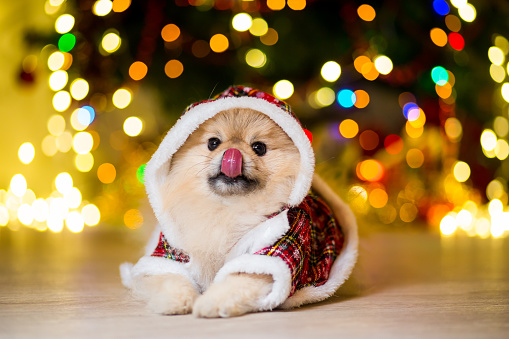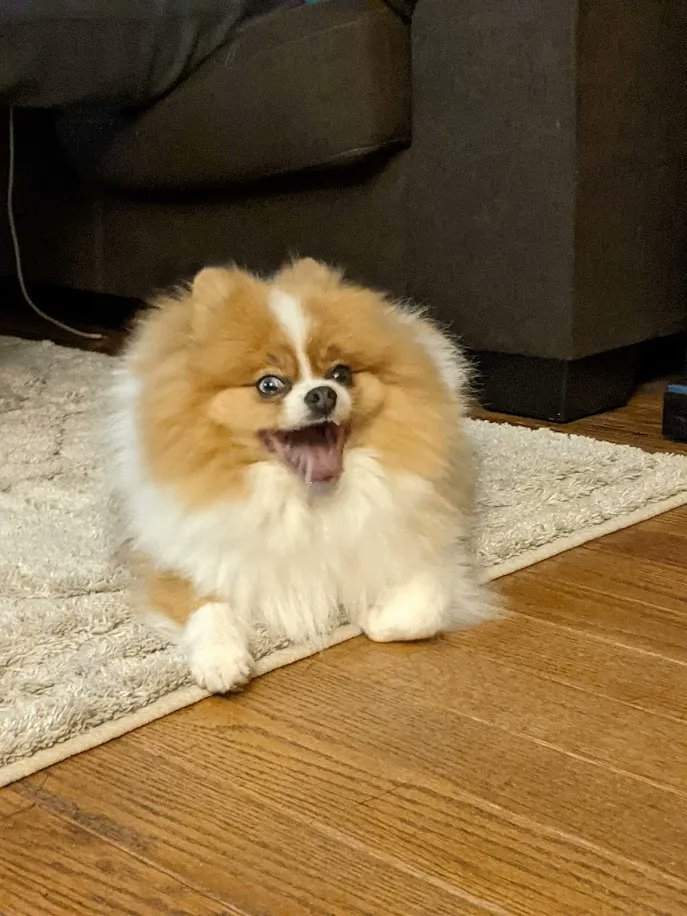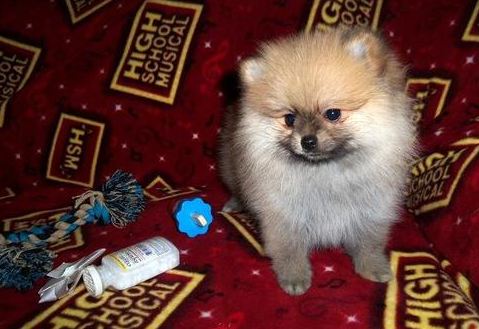pomeranian breeders Toronto
pomeranian breeders Toronto
12 Pros and Cons of Owning a Pomeranian
pomeranian breeders Toronto
pomeranian breeders Toronto
About the Pomeranian Dog
pomeranian breeders Toronto
pomeranian breeders Toronto
Introducing the Pomeranian—the dog breed known for attracting many aristocrats.
This dog is so popular that even Queen Victoria owned one.
After a visit to Florence, Italy, Queen Victoria was so smitten with this breed that she returned to Britain with several “Poms” in tow.
There are even reports that when the queen was on her death bed in 1901, her favorite Pom, Turi, kept vigil at the foot of her bed.
If you are interested in this breed, knowing the pros and pros is paramount before taking the ownership plunge.
There are several pros and cons to owning a Pomeranian.
Therefore, prospective dog owners should carefully consider them. As the saying goes, “forewarned is forearmed.”
Let’s face it though: being cute as a button, it is easy to forgive all the “issues” these little bundles of joy may incur.
If some issues aren’t addressed at their earliest onset, they can become more problematic, to the point of potentially leading to heartbreaking regrets and even considerations about re-homing.
But knowledge is power, so before getting excited about this breed, learn more about it and make an informed decision!
pomeranian breeders Toronto
pomeranian breeders Toronto
Marco on Queen Victoria’s Breakfast Table by Charles Burton Barber, 1892
pomeranian breeders Toronto
pomeranian breeders Toronto
6 Pros About Pomeranians
pomeranian breeders Toronto
pomeranian breeders Toronto
Here are some pros about the Pomeranian.
pomeranian breeders Toronto
pomeranian breeders Toronto
1. Appealing Looks
pomeranian breeders Toronto
pomeranian breeders Toronto
The first thing that lures people to these dogs is their appealing looks.
Poms are blessed with adorable, smiling, fox-like faces.
Their pricked ears, dark, almond-shaped eyes, thick coats, and heavily plumed tails are very cute.
All these traits are testimony of this breed’s Nordic descent.
In fact, Poms descend from the large sled dog breeds, but it is thanks to Queen Victoria, who selectively bred them to be smaller in size, that we can carry these dogs around and keep them on our laps.
It all started in 1888, when Queen Victoria stumbled on Marco, an especially small Pomeranian on her trip to Florence, Italy.
Marco weighed about 12 pounds, while most other Poms were regularly closer to 20.
pomeranian breeders Toronto
pomeranian breeders Toronto
2. A Convenient Size
pomeranian breeders Toronto
pomeranian breeders Toronto
Small dogs have been all the rage in the past few years.
How small are Poms though? In general, they weigh around three to seven pounds—the perfect size that comes with many perks. This has made them one of the most popular toy breeds.
Being small, they cost less to feed, board, treat, and generally care for.
Because they require less food and water, Pom owners don’t need to pick up elephant-size poop piles or dry up pee puddles the size of Lake Michigan.
They are also easy to carry around and are sometimes allowed on planes in the cabin with you.
You can bring him or her to places where bigger dogs aren’t allowed.
Best of all, a Pom won’t drag you on walks, kill your neighbors’ cat, or terrorize your mail carrier.
pomeranian breeders Toronto
pomeranian breeders Toronto
3. A Happy Camper
pomeranian breeders Toronto
pomeranian breeders Toronto
Owners of Poms describe them as being happy-go-lucky dogs who are fun to be with and who brighten your day.
They are energetic, but in a flexible way, acting mostly hyper when exciting events take place.
They calm down when nothing major is going on.
Just make sure to meet this breed’s needs to romp around and be a “dog” before expecting them to want to cuddle.
Gift them with a fuzzy ball to chase or some squeaky toys to wake up their hunting instincts within.
These dogs enjoy receiving attention, and they love being with their families.
Some Poms, in particular, develop a strong attachment to one person.
Another plus is that these fluffy fellows tend to get along with other pets.
It is not unusual for a group of them to run around and play together with little or no fuss, even among males.
Some may be bossy, however, and may aggravate strange dogs, regardless of their size.
Owners of this breed describe their dogs as being spunky, bright, and vivacious little bundles of joy that bring sunshine into their lives.
pomeranian breeders Toronto
pomeranian breeders Toronto
4. Smart and Trainable
pomeranian breeders Toronto
pomeranian breeders Toronto
All dogs are ultimately trainable if you have patience and have some basic skills, but these dogs are particularly “brainy,” which means that they are smart and you can train them to do lots of things.
When you have a smart dog, however, it can go against you, meaning that they’ll use their brains to get into mischief.
However, you can outsmart them and get them to do what you want.
Once you do that, your Pom will magically transform and will be eager to learn from you and have fun in the process, too.
Indeed, many Pomeranians have reached high levels of honor in the obedience ring, and they’re quick at learning new tricks.
Just make sure to use gentle training techniques with these little fellows (as it should be with any dog of any size).
pomeranian breeders Toronto
pomeranian breeders Toronto
5. A Tough Cookie
pomeranian breeders Toronto
pomeranian breeders Toronto
While it’s true that this breed can be quite fragile due to their size, you should not underestimate them because of their fluffy looks.
These are rather rustic dogs blessed with overall good health.
Some owners report seeing the vet only for vaccinations and nothing more.
Of course, there are exceptions, but it is nice to see healthier dog breeds instead of many others affected by a plethora of health problems.
Perhaps the biggest issue in this breed is the predisposition for luxating patellas.
However, if you get one from a reputable breeder who health tests for it, you can lower the chances of yours developing this condition.
Another issue that is common in small dogs is tracheal collapse.
Make sure to use a harness rather than a collar to help prevent this.
These small dogs also tend to have crowded teeth enclosed in a small mouth and require regular teeth brushing.
pomeranian breeders Toronto
pomeranian breeders Toronto
6. A Long-Living Companion
pomeranian breeders Toronto
pomeranian breeders Toronto
One of the biggest plus sides of this breed is their long lifespan.
The average lifespan of these dogs is around 15 years, but it is not unheard of for some to live up to 18 or even 20 years!
pomeranian breeders Toronto
pomeranian breeders Toronto
6 Cons of Pomeranians
pomeranian breeders Toronto
pomeranian breeders Toronto
Here are some common issues with Pomeranians.
pomeranian breeders Toronto
pomeranian breeders Toronto
1. Watchdog Syndrome
pomeranian breeders Toronto
pomeranian breeders Toronto
Don’t be fooled by this breed’s fluffiness and reputation of being a lap dog: Poms are keen watchdogs who take their job very seriously.
You can literally see their ears twitching even when they seem to have fallen asleep.
These dogs are quick to sound the alarm at every suspicious encounter.
This can make them somewhat troublesome for those living in condos and close-knit neighborhoods.
We can’t blame them though—if we look at their past history, these fluffy dogs have Spitz heritage in their blood, and their ancestors pulled sleds and sounded the alarm if intruders were detected.
Fortunately, these barking tendencies can be toned down just a notch for those willing to socialize their dogs as puppies.
You can spend some time training them to ignore certain stimuli and “hold their tongues,” so to say.
2. Lots of Determination
Poms are smart and determined dogs.
When they want something, they’ll be persistent and won’t give up easily.
This is often due to a human’s flaw of not being able to say no to these cute faces.
Owners can often fall for the adorable tactics these dogs use to get what they want.
These opportunistic pups are ready to jump in if they sense any weaknesses in your ability to provide rules.
Let’s just say that they have an independent streak. You are eating?
Poms will look at you adoringly or they will engage in some cute circus stunts in hopes of you giving in.
If you give in and give them a little piece of food, you are doomed.
They will turn into a table-side companion for life.
And if you don’t give them what they want because you have decided to toughen up your rules, they may escalate to pawing at you, barking at you, and trying to get a morsel from different people or different sides of the table.
3. Potty Training Problems
Small dogs may pose some extra challenges in the potty training department.
The biggest problem is that since they’re so low and small, it is easy for them to just sneak behind a couch or table to do the deed.
Small puddles may go unnoticed for hours or even days if you are not attentive.
Uncleaned areas make your home smell like a doggy bathroom, so don’t be surprised if your Pom will want to soil in the same places over and over.
Fortunately, there are several things you can do though to heighten your chances for success.
First of all, avoid scruff shakes, putting your pup’s nose in his mess, or scolding your Pom puppy for having accidents in the home; this approach just teaches dogs to hide to pee and poop.
Instead, always supervise your pup, learn to recognize early signs your puppy needs to go potty, and upon noticing any of them, take your puppy to the designated area and praise and reward them lavishly for going there.
When you can’t actively supervise your pup, keep him in a crate (for no more than he can hold it), or for longer absences, put him in an indoor designated area (like a small bathroom or playpen) with an area covered with some pee pads in case he needs to potty.
You should learn how to clean messes properly. Use an enzyme-based cleaner (like Nature’s Miracle) to clean and neutralize odors and invest in a black light to find any old messes.
While you are at it, every time you take your pup outside to potty, aim to teach your puppy to go potty on command.
4. The Fragility of Toy Breeds
The Pomeranian is categorized into the toy group, which includes several small dog breeds bred down in size for specific tasks or for the purpose of having a smaller pet.
While appealing, the diminutive size of these dogs comes with the cost of increased fragility.
This doesn’t mean they need to live in a bubble, it just means that you need to be extra careful around them.
For instance, you can seriously injure a Pomeranian puppy if you happen to accidentally sit on him, fall on him, or drop him.
A toddler or clumsy child may easily stumble on these small dogs.
Their loud voices and unpredictable movements can cause stress and fear in the long run.
With older children, these dogs tend to fare well as long as they are old and mature enough to tell the difference between a stuffed animal and a live dog.
Even on their own, Poms are at risk for injuries from jumping off high furniture.
When walking your dog, you always have to be vigilant to make sure no large dogs try to attack him.
All it takes is a quick grab and shake to potentially injure or even kill a small dog.
5. Not Your Average Small Dog
Many people imagine Poms as the average small dog who loves to be carried in a purse and who will warm laps for hours on end. Well, not so fast.
They are different from the average small dogs considering that they descend from sled dogs and have Spitz heritage like huskies, Alaskan Malamutes, and Akitas.
Poms are not fragile dogs.
They have an independent streak and may even enjoy chasing little critters.
Given the choice, they may prefer to roll in disgusting stuff, eat gross things found on the ground, and dig rather than stay on a lap… or do all of that in a sequence to their owner’s dismay.
Courtesy of their heritage, they are also quite energetic despite their size.
Their piston-like legs can propel them at full speed around the home.
You’ll need to find ways to keep these balls of energy busy.
Make sure to have lots of toys, food puzzles, and time to keep their brains and bodies busy.
6. Coat Care
The Pom’s glorious coat comes with a price: you’ll need extra time for coat care if you want to avoid annoying mats and want to minimize shedding, which can be particularly heavy at certain times of the year.
The good news is that all you really need to do is brush the coat daily and provide a bath every now and then; occasional trimming may be needed, but only if the groomer or vet recommends it.
Just because Poms were cherished by aristocratic ladies doesn’t mean they are a cross between a teddy bear and a dog.
They will roll in cow poop given the opportunity and don’t mind puddles or dirt staining their luxurious coats.
On the plus side, you’ll be surprised at how easy it is to clean their coats when they’re wet and dirty.
One skin condition worth mentioning in this breed is black skin disease, a genetic skin condition known to turn the dog’s skin black.
This disease can also cause skin to fall off.
Are Pomeranians Easy to Train?
This breed is relatively easy to train if you are consistent and put in the work to teach your dog how to behave.
Here are some tips to keep in mind during the training process.
-
Socializing: Frequently taking your dog to other places and seeing other people and dogs can help them feel more comfortable in unfamiliar locations. Without this training, your pet can become scared and aggressive with strangers.
-
Basic Commands: With the use of treats, your puppy can learn simple commands, such as sitting or coming to you. If you reward them with a treat when they correctly respond to a command, they will associate that command with a potential treat.
-
Barking: Because of their protective nature, Poms have a tendency to bark frequently at strangers or anything surprising. You can train them to ignore things and even have a command for them to stop barking. As a puppy, reward them with a treat if they stop barking when you command them to be quiet. This training will go a long way in helping to manage their barking.
-
House Training: Smaller dogs mean smaller bladders. This means you will have to keep an eye on Poms to avoid any accidents. Be vigilant to any signs that your dog will have to go potty. Rewarding with treats when your dog goes potty outside will reinforce the idea that outside is the place to go.

















